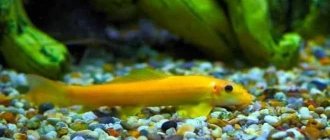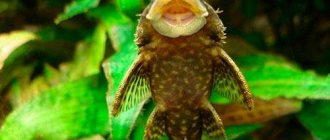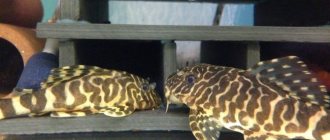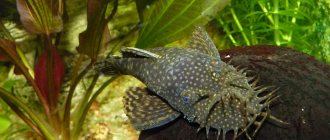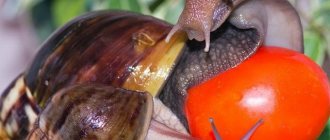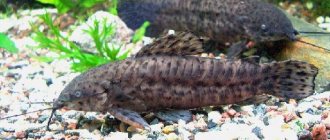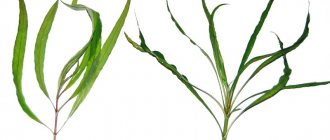Compatibility
As practice shows, an albino is compatible with small and medium-sized fish. Problems arise only when kept with other species of catfish or with several males together.
The fish is very territorial. Although I have not personally observed this, it is said that American cichlids can cause eye damage, so I would caution you against keeping them in the same tank.
Interestingly, ancistrus have means to protect themselves from attack. They are covered with hard scales and have spiny fins, in addition, males have spines on their gills, and in case of danger they bristle with them.
So the fish itself is by no means defenseless. Life expectancy is up to 5 years, but females live slightly less.
This is interesting
- Ancistrus catfish is popularly called sucker catfish.
- The maximum body length of the ancistrus catfish depends on the water temperature: the higher the temperature, the smaller the catfish.
- Ancistrus do not have a swim bladder, unlike other fish. Therefore, in order to swim some distance without holding on to objects with their suction cup mouth, fish have to work very actively with their fins.
- If there is no male in the aquarium, the female can change sex. However, this happens in many other fish species.
Keeping in an aquarium
Fish do not require special conditions for keeping, but there are general requirements that must be met. Albinos prefer water temperatures between 20-25 degrees, and a pH between 6.5 and 7.6 (although some have had success keeping them at 8.6).
Fish need plenty of hiding places and you should definitely add some in your tank. These can be ceramic pots, pipes or coconuts.
A well-planted aquarium is also not very roomy for comfortable keeping.
Frequent water changes are also necessary, I usually change 20-30% of the volume weekly, but I feed my plants generously with fertilizers and such replacement is necessary in order not to upset the balance in the aquarium.
If you do not use fertilizers, you can replace about 30% of the water. Changing the water weekly also helps get rid of waste, which fish produce quite liberally.
Since these fish are also sensitive to the amount of nitrates in the water, it is necessary to install filtration, especially if the aquarium has no or few plants.
Catfish "Ancistrus albino" (Ancistrus dolichopterus albino)
Ancistrus albino (lat. Ancistrus dolichopterus albino) is often popularly called the sucker catfish, a native of South America and the Amazon basin. It lives in very different bodies of water, from swamps with low oxygen content, to the deep and dark waters of large rivers. There are several types of Ancistrus catfish on the market, but the common one is the most common.
Brief information:
- Minimum aquarium volume: 15 liters (juveniles)
- Content: Light
- Water parameters: pH 6-7.3 dH up to 10°, KH up to 2°
- Water temperature: 20-26°C
- Maximum size: up to 15 cm
Keeping in an aquarium
A simple ancistrus, or sticky catfish, is a great addition to almost any freshwater aquarium. He is the best algae fighter as he needs large amounts of food daily and is tireless. While other chain catfish can grow to the size of river monsters in an aquarium, the aquarium catfish Ancistrus remains relatively small and rarely reaches a size of more than 15 cm. Because of this, they are much better suited to the role of aquarium cleaner than other catfish species. . The aquarium fish Ancistrus requires fairly spacious aquariums. Since the fish is quite active, it needs a lot of space where it can hide and feed. The bulk of her life is spent searching for food, eating it, and searching again. Because of this, a decent amount of waste is generated, which quickly pollutes the water. It is recommended to install powerful filters in aquariums with sucker catfish. How long does Ancistrus live? Quite long, up to 6-8 years, but usually dies earlier.
In nature, adult ancistrus try to hide in caves and under flooded snags, where they are difficult to detect. It is extremely necessary to reproduce an analogue of the natural biotope in the aquarium. You can add ceramic pots, coconuts, or large pieces of driftwood that they like to crawl under and hang upside down.
When choosing a filter for them, an internal one will be the most economical option, and even a simple washcloth installed in it will purify the water quite effectively. However, if funds allow, it is better to buy an external canister filter, which will be the best choice for any tropical aquarium.
Feeding
As already mentioned, the aquarium fish Ancistrus loves to eat and needs a lot of food. The main diet is plant-based; spirulina-based foods, which are available in tablets, are well suited. The tablets dissolve slowly in water and have an attractive odor for Ancistrus vulgaris. You can also add vegetables, which will significantly expand their diet. Hungry ancistrus eat pieces of zucchini, mugs of cucumbers and lettuce leaves to the ground. Broccoli and many other types of vegetables are also loved. But do not forget to remove uneaten food debris to avoid water rotting!
If you expect to get offspring from your Ancistrus, you should feed them frozen food. Their delicacies include bloodworms and correts, and they can ignore other types of live food. Since the fish feed from the bottom, make sure that there is easy access to the food, otherwise they simply will not notice it.
Breeding:
Ancistrus vulgaris is easy to breed - if there is enough hiding place in the aquarium, they will do the rest themselves. But you should try to keep more females than males unless you have a very large aquarium. Otherwise, the males will start fights for territory; ancistrus are very territorial, they quickly occupy available shelters and fight with other males for their control. However, if possible, other males eat the eggs laid in the opponent’s hiding place. When preparing to breed Ancistrus vulgaris, first of all decide whether you have a pair. You can tell a male from a female by the presence of horns on their heads. Also males are larger than females.
When the male is ready to spawn, he begins to clean out the prepared shelter and drive other fish away from it. As soon as the shelter is ready, the male attracts the female by striking his tail. After inspecting the chosen shelter, the female lays eggs on its walls. Ancistrus caviar is large, bright orange, hanging in a cluster. As soon as the female spawns, the male inseminates the eggs and drives the female away, taking over the protection of the offspring. After spawning, the female can be removed, her role is played. If there are other female ancistrus in the aquarium, they can also spawn in a shelter, thus one male guards the eggs of several females.
The eggs will ripen for 7-10 days until fully mature fry emerge from them. The male will guard them until the fry swim on their own. As soon as this happens, the male can and should be removed. During the first days, the fry can be fed with ciliates or ground spirulina. A little later, you can add food for shrimp and plant food for adult Ancistrus vulgaris to the diet.
Feeding
Plant foods are preferred in the diet - lettuce, cabbage, dandelion leaves, spirulina and dry food for ancistrus. They really love zucchini and patiently wait in the corner of the aquarium for their favorite treat.
They know absolutely exactly when and where it will be waiting for them.
As I mentioned before - driftwood is a good idea. Ancistrus love to eat snags, as they contain lignin and cellulose, which are very necessary for the proper digestion of these catfish.
I noticed that they spend a significant portion of their time processing the snags in the aquarium. They enjoy chewing on their favorite lignin and feeling safe among the snags.
Maintenance and care
Golden photo can be enlarged
Ancistrus catfish is quite simple to keep. The fish is peaceful and gets along well in almost any freshwater tropical aquarium with a temperature of 22-26 C. It can withstand temperature changes from 18 to 33 C. In aquariums it has adapted to almost any composition of water, although in nature it lives mainly in slightly acidic water. Loves clean, oxygenated water. Therefore, intensive aeration of water is desirable, in the flows of which ancistrus prefer to stay.
The aquarium should be fairly densely planted with plants and contain various shelters in which these fish like to be. It is desirable to have driftwood, which these catfish happily scrape.
Albino photo can be enlarged
The male Ancistrus is exterritorial and actively defends the chosen shelter. The fish are crepuscular and are most active in the evening. They feed on various foulings from all surfaces of the aquarium. If there is a shortage of food, they may begin to scrape the plants and spoil them, especially young shoots. They partially feed on leftover food from other inhabitants of the artificial reservoir.
If there is a group of ancistrus or they are kept in a small aquarium, additional feeding of these animals with plant food is necessary. You can use scalded lettuce or cabbage. Industrial food for herbivorous fish in the form of tablets is also suitable.
Reproduction
Ancistrus males and females can be easily distinguished by branched outgrowths on the head. In addition, females are always shorter and rounder.
Ancistrus can easily spawn in a community aquarium, however, to preserve the offspring, it is better to place the pair in a spawning aquarium. In such an aquarium there must be shelters: ceramic tubes, coconuts, etc. It is inside them that the eggs are thrown and fertilized. After spawning, the male kicks out the female and begins to care for the eggs himself: he fans them with his fins and collects dead or unfertilized ones. At this time, the female should be removed from the spawning area. After about a week, the eggs will hatch into babies. As soon as they are able to swim and feed on their own, the male should also be removed from them. Live microfeeds are suitable for feeding Ancistrus fry: Artemia nauplii and ciliates.
Ancistrus golden or albino: maintenance, care, description, breeding, photo
No aquarium community is complete without catfish. The albino ancistrus catfish is one of the common inhabitants of aquariums, being a very unusual fish with a calm character and interesting behavior: this catfish does not bully anyone, and no one pesters it. It gets along best with goldfish, angelfish, neons, loaches, and cichlids. But, guarding the eggs, the male drives other bottom-dwelling aquarium fish away from the location of the clutch with developing eggs.
These catfish are often bred in aquariums for two important reasons:
- they are very simple in content;
- bring invaluable benefits, being aquarium cleaners: they “clean” the walls and decorations of aquariums from algae, which in the form of fouling cover the interior of the aquarium. They eat up leftover food that has fallen to the bottom and even dead fellow fish.
ALBINOS AND AQUARIUM PLANTS
Most readers who like to keep aquarium plants in addition to fish will have a question: “Do white ancistrus damage plants?” They themselves are known to be excellent aquarium cleaners, but some claim that they can damage the delicate leaves of plants such as cabomba. Therefore, if you have a lot of thin-leaved, dissected aquarium plants, then hungry ancistrus can damage them. My experience is that albinos have never damaged a single plant in my aquarium, but I note that they are always well fed and their diet contains a sufficient amount of plant food.
Appearance and character
The catfish ancistrus albino is a variety of the common ancistrus and has the Latin name Ancistrus dolichopterus var. Albino. It differs from the ordinary one only in color. Peaceful character, easy proximity to other fish and the habit of hiding inside shelters or under snag stones - everything is like that of an ordinary ancistrus. Sometimes this catfish is called white ancistrus, which reflects its very pale yellow body color, which combines interestingly with the red color of its eyes.
The albino variation of the common ancistrus also has a subspecies - the golden ancistrus catfish, which received its name due to the bright, rich golden color of the body of males (in females the “goldenness” is slightly paler).
The differences between females and males of all ancistrus are very clear and easy. By the time they grow up, leathery outgrowths begin to appear on the head of males, branching like bushes. The entire head of an adult male is covered with these “skin bushes”. This “bushiness” on the head of male ancistrus can be associated with the beards that grow in men. Look at the photo of a male albino ancistrus with projections on the head. Females may not have such projections, and if they are present, then only at the edges of the head.
CONTENT IN THE AQUARIUM
White ancistrus do not require special conditions for maintenance, but there are general requirements that must be met. Albinos prefer water temperatures between 20-25 degrees, and a pH between 6.5 and 7.6 (although some have had success keeping them at 8.6). Fish need plenty of hiding places and you should definitely add some in your tank. These can be ceramic pots, pipes or coconuts. A well-planted aquarium is also not very roomy for comfortable keeping.
Frequent water changes are also necessary, I usually change 40-50% of the volume weekly, but I feed my plants generously with fertilizers and such replacement is necessary in order not to upset the balance in the aquarium. If you do not use fertilizers, you can replace about 30% of the water. Changing the water weekly also helps get rid of waste, which ancistrus produce quite abundantly. Since these fish are also sensitive to the amount of nitrates in the water, it is necessary to install filtration, especially if the aquarium has no or few plants.
FEEDING
Plant foods are preferred in the diet - lettuce, cabbage, dandelion leaves, spirulina and dry food for ancistrus. They really love zucchini and patiently wait in the corner of the aquarium for their favorite treat. They know absolutely exactly when and where it will be waiting for them. One pet store salesman told me that he fed albino ancistrus raw potatoes, but my attempts were unsuccessful.
As I mentioned before, driftwood is a good idea in an ancistrus tank. Golden ancistrus love to eat snags, as they contain lignin and cellulose, which are very necessary for proper digestion of ancistrus. I noticed that they spend a significant portion of their time processing the snags in the aquarium. They enjoy chewing their favorite legnin and feeling safe among the snags.
BREEDING
For those who are thinking about breeding golden ancistrus, I will tell you some details of the preparation. First of all, a voluminous aquarium, from 100 liters or more, with many shelters and caves. As soon as a pair of breeders is determined, they will hide together in the chosen shelter and the female will lay 20-50 eggs. The male will guard and fan the eggs with his fins until they mature. This is approximately 3-6 days. But the female can and should be removed after spawning.
During the period of caring for the eggs, the male will not feed, don’t let this scare you, this is how nature intended. Once the eggs hatch, the fry will not immediately emerge from it, but the larva will remain in place due to its large yolk sac.
She feeds from it. Once the contents of the bag are eaten, the fry is strong enough to swim, at which point it is recommended to remove the male. You can feed the fry of golden ancistrus with frozen shrimp, bloodworms, but the basis should be plant food. A partial water change two to three times a week is also necessary. The fry can be transferred to a community aquarium as soon as it reaches a size of about a centimeter. I hope this article will help you in keeping and breeding ancistrus albino. My experience with golden ancistrus is only positive, it is a beautiful, peaceful and useful fish!
